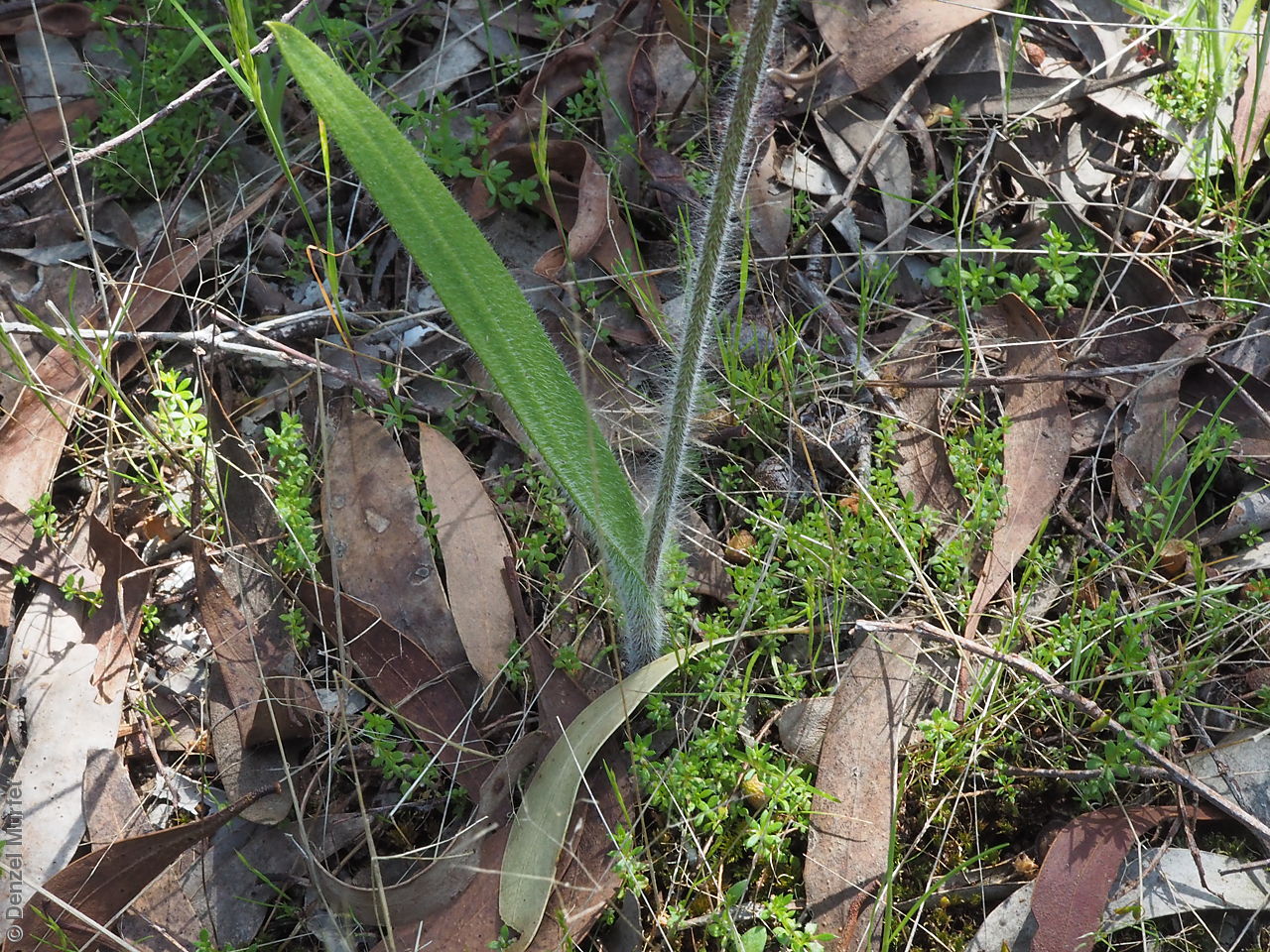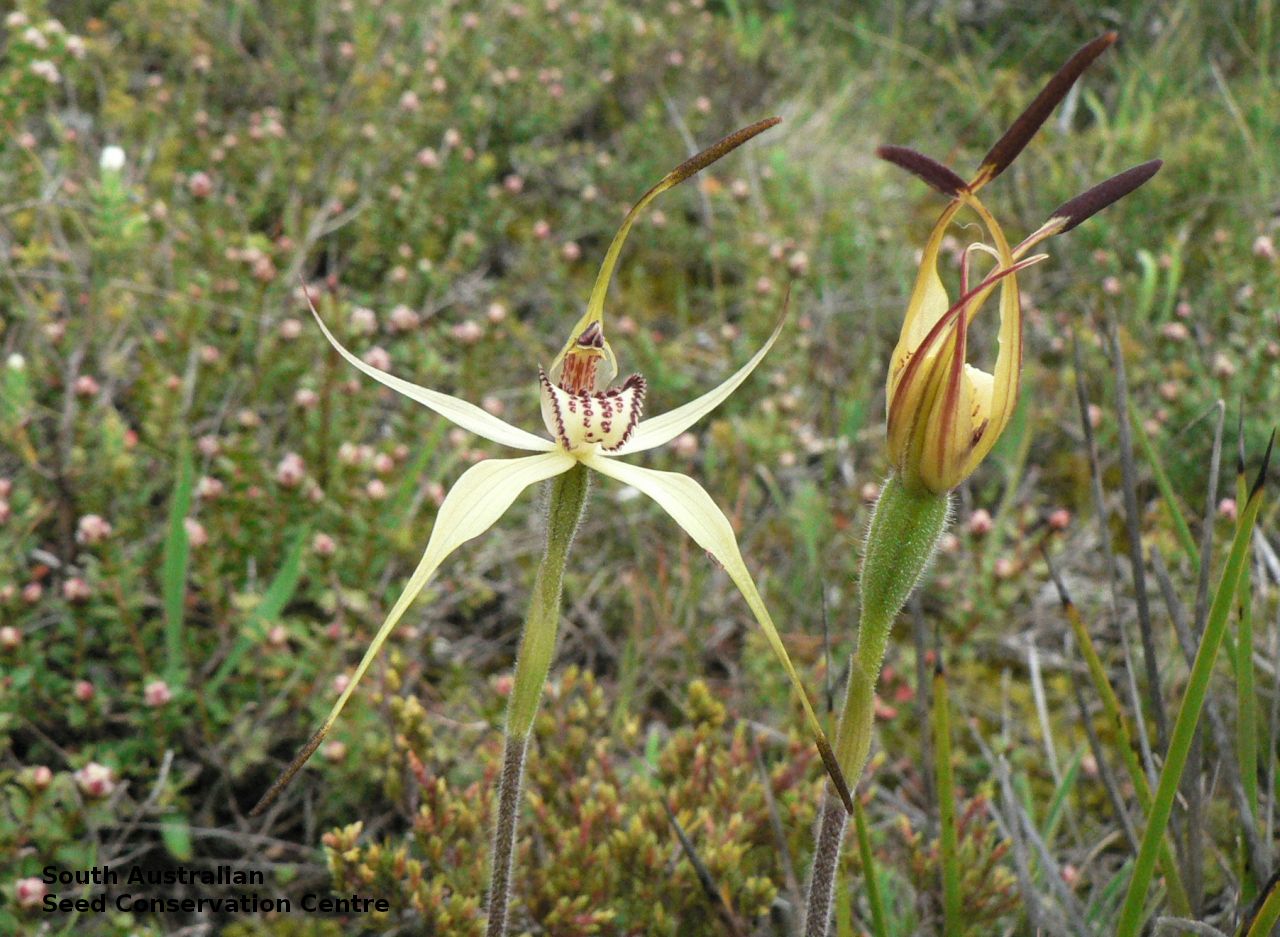












Botanical art
Prior names
Calonemorchis richardsiorum
Arachnorchis richardsiorum
Calonema richardsiorum
Caladenia aff. hastata (Nicholls)Rupp
Caladenia sp. A
Etymology
Caladenia from the Greek 'callos' meaning beauty and 'aden' meaning a gland; referring to the colourful labellum and the glistening glands at the base of the column that adorn many of the species. Richardsiorum named in honour of Helen and Barry Richards of Victoria for their dedication and unerring quest for improved knowledge on the propagation and cultivation of Australian terrestrial orchids.
Distribution and status
Endemic to South Australia and found only in the lower South-east, growing in coastal vegetation. Native. Very rare in South Australia. Endangered in Australia under the EPBC Act.
Herbarium region: South Eastern
NRM region: South East
AVH map: SA distribution map (external link)
Plant description
Annual terrestrial orchid growing from an underground tuber to 40 cm high with a single flower and a single lanceolate leaf to 22 cm long. Flower is yellow green up to 40 mm wide. Sepals have prominent but short black clubs 8-10 mm long. The labellum is is greenish-cream has maroon calli and toothed margins. Flowering between September and November. Fruits are brown papery ellipsoid capsule. Seeds are very small brown ellipsoid seed with a long translucent brown mesh-like covering.
Seed collection and propagation
Collect seeds between December and February. Collect fat capsules as they start to dry and turn brown. Pods will split and release the seeds quickly and will require monitoring. To increase the chances of collecting mature pods, it is recommended that a small breathable bag (ie. Organza bags) be used to enclose the developing capsules. Place the capsules in a container that will hold fine seeds and leave to dry for a few weeks or until the capsule split. Then carefully hold the capsule and tap it gently to release the seeds. Store the seeds with a desiccant such as dried silica beads or dry rice, in an air tight container in a cool and dry place, a refrigerator, or in liquid nitrogen. For the NVC South East Orchid Project six populations consisting of more than 700 individuals in total were recorded from Rivoli Bay, Nora Creina, Cullen Reserve, Lankys Well, Teeluk and Little Dip Conservation Park. Approximately 2,500,000 seeds (1.5 g) were banked from these six populations. Seed viability ranged from 68% to 90%. Seed germination in Caladenia species is difficult without compatible mycorrhizal fungi.
| Location | No. of seeds (weight grams) | Number of plants | Date collected | Collection number Collection location | Date stored | % Viability | Storage temperature |
|---|---|---|---|---|---|---|---|
| MSB | 593,100 (0.15 g) | Marcia Lorenz South Eastern | 81% | ||||
| 1 pod | 7-Nov-2007 | C. Dickson South Eastern | 1-Nov-2016 | N/C | -80°C | ||
| 1 pod | 7-Nov-2007 | C. Dickson South Eastern | 1-Nov-2016 | N/C | -80°C | ||
| 1 pod | 26-Oct-2007 | C. Dickson South Eastern | 1-Nov-2016 | N/C | -80°C | ||
| 1 pod | 26-Oct-2007 | C. Dickson South Eastern | 1-Nov-2016 | N/C | -80°C | ||
| 1 pod | 9-Nov-2007 | C. Dickson South Eastern | 1-Nov-2016 | N/C | -80°C | ||
| 2 pods | 26-Nov-2007 | C. Dickson South Eastern | 1-Nov-2016 | N/C | -80°C | ||
| 5-Nov-2002 | V. Natt Yorke Peninsula | 1-Nov-2016 | N/C | -80°C | |||
| BGA | 230,000 (0.138 g) | 12 pods | Oisin Sweeny South Eastern | 1-Nov-2016 | 81% | -80°C | |
| BGA | 220,000 (0.123 g) | 4 pods | Oisin Sweeny South Eastern | 1-Nov-2016 | 90% | -80°C | |
| 3 pods | 27-Nov-2007 | D. Hinchliffe South Eastern | 1-Nov-2016 | N/C | -80°C | ||
| 5-Nov-2002 | V. Natt Yorke Peninsula | 1-Nov-2016 | N/C | -80°C | |||
| 5-Nov-2002 | V. Natt Yorke Peninsula | 1-Nov-2016 | N/C | -80°C | |||
| 5-Nov-2002 | V. Natt Yorke Peninsula | 1-Nov-2016 | N/C | -80°C | |||
| 5-Oct-2002 | V. Natt Yorke Peninsula | 1-Nov-2016 | N/C | -80°C | |||
| 5-Nov-2002 | V. Natt Yorke Peninsula | 1-Nov-2016 | N/C | -80°C | |||
| 1 pod | 27-Nov-2007 | D. Hinchliffe South Eastern | 1-Nov-2016 | N/C | -80°C | ||
| 1 pod | 21-Nov-2007 | D. Hinchliffe South Eastern | 1-Nov-2016 | N/C | -80°C | ||
| BGA | 250,000 (0.149 g) | 21 pods | 4-Jul-2005 | C. Dickson South Eastern | 1-Nov-2016 | 79% | -80°C |
| BGA | 490,000 (0.294 g) | 29 pods | 4-Jul-2005 | C. Dickson South Eastern | 1-Nov-2016 | 89% | -80°C |
| 1 pod | 9-Nov-2007 | C. Dickson South Eastern | 1-Nov-2016 | N/C | -80°C | ||
| BGA | 380,000 (0.224 g) | 26 pods | 4-Jul-2005 | C. Dickson South Eastern | 1-Nov-2016 | 85% | -80°C |
| BGA | 320,000 (0.192 g) | 29 pods | 4-Jul-2005 | C. Dickson South Eastern | 1-Nov-2016 | 68% | -80°C |
| 2 pods | 21-Nov-2007 | D. Hinchliffe South Eastern | 1-Nov-2016 | N/C | -80°C | ||
| 21-Nov-2007 | D. Hinchliffe South Eastern | 1-Nov-2016 | N/C | -80°C | |||
| 21-Nov-2007 | D. Hinchliffe South Eastern | 1-Nov-2016 | N/C | -80°C | |||
| 1 pod | 9-Nov-2007 | C. Dickson South Eastern | 1-Nov-2016 | N/C | -80°C | ||
| BGA | 350,000 (0.211 g) | 7 pods | Oisin Sweeny South Eastern | 1-Nov-2016 | 80% | -80°C |
Number of plants: This is the number of plants from which the seeds were collected.
Collection location: The Herbarium of South Australia's region name.
% Viability: Percentage of filled healthy seeds determined by a cut test or x-ray.